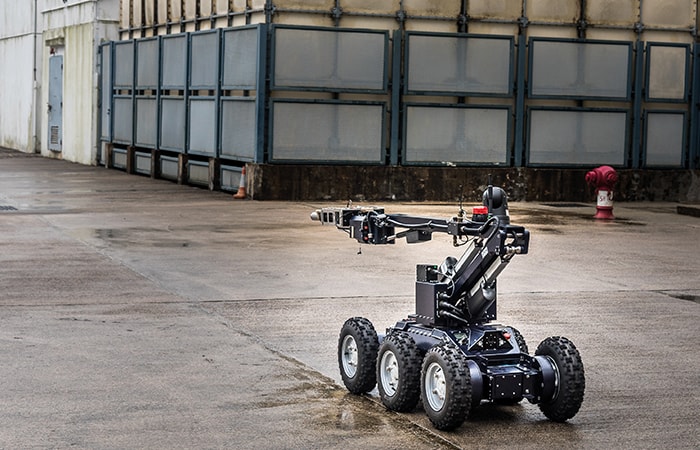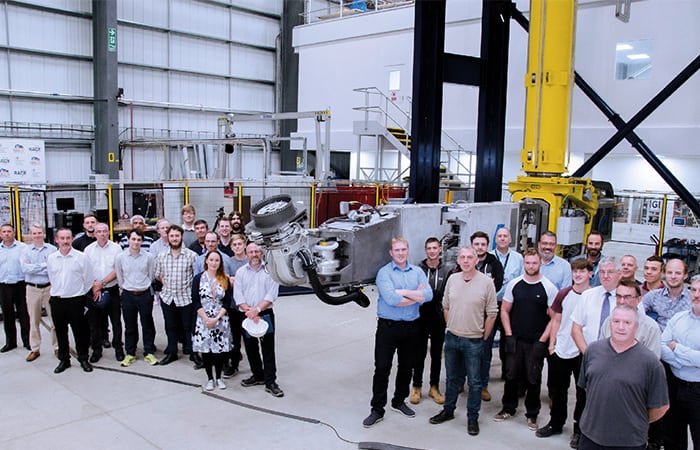Fusion research is leading to spin-off technology that could make autonomous vehicles a reality in a shorter time frame. Stuart Nathan reports.
Nuclear fusion is often criticised as being a never-ending research project, whose only payoff – though undoubtedly enticing – is always 30 years away. However, at the UK centre for fusion research, the site of the world’s largest fusion reactor and the only one currently capable of actual fusion, the Joint European Torus (JET) at Culham in Oxfordshire, the perpetual research project is having real-world payoffs, albeit in unexpected places.

The key to this is RACE-Test, the testing facility for remote applications in challenging environments (RACE). Originating in the research effort to support the development of robotic devices for maintaining and installing equipment inside the cramped and dangerous confines of a fusion reactor – the materials of the reactor shell become activated by the neutron bombardment triggered by the nuclear fusion reaction – RACE-Test is now involved in a series of projects both inside and outside the fusion application.
Although assembly on ITER, the successor to Culham’s reactor JET, has not yet begun, initial design work of ITER’s successor, DEMO, planned to be the first fusion reactor to actually generate electricity, is already under way, and development projects for the robots that will install equipment inside its huge vacuum vessel dominates the main experimental hall, much of which is occupied by TARM (telescopic articulated remote mast), a single robot arm in excess of 10m long, attached to a vertical mast running from floor to ceiling.
On my visit, this was awaiting the installation of a manipulator on its end, which will be used to investigate the manipulation of very heavy objects at full reach.
The feedback from sensors on each of its joints is fused with position data from cameras and IR sensors placed around the hall. This is an example of the AI techniques of ‘industry 4.0’ in action, notes RACE-Test facilities manager Oliver Huke. Meanwhile, mock-ups of sections of the planned reactor, such as its access ports, are under construction in other parts of the cavernous, gymnasium-like space.
Much of RACE’s operations are concerned with the nuclear sector, both fusion and fission. “We are increasingly concerned with decommissioning, not just at Sellafield but we have projects there, internationally,” explained Steve Wheeler, head of RACE operations. “We are also involved in RAIN (robotics and AI for nuclear), a funded research hub led by the University of Manchester and also involving the Oxford Robotics Institute, Sheffield, Liverpool, Nottingham and Bristol [universities]. That’s lower technology readiness level work, but applied research, looking at real applications of robotics, remote handling and AI to solve actual problems in hazardous environments.”

Such environments are where RACE comes into its own, Wheeler adds. “We’re involved in a wide range of those environments, and that can be for inspection, maintenance, upgrades or decommissioning, where it’s often associated with size-reduction tasks; cutting things up and taking them out of their operational location for treatment and/or disposal.
“We have about 150 people here, organised into a mechanical design team, an electrical systems team, a control and software team and an operations team. It’s the operations engineers who have the experience of doing things remotely. We have 35,000 hours of operational experience in doing difficult tasks entirely remotely, and that’s what makes us unique; we don’t build or sell robots but there are lots of people who do. We are a business unit of the Atomic Energy Authority: we don’t compete with other companies in the remote handling sector; we support them in winning contracts and bids and they subcontract to us to access our expertise.”
As Wheeler says, the facility’s expertise in developing remotely operated equipment to work in demanding and dangerous environments is increasingly in demand from other industries. In laboratories housed in large marquees outside the main hall, wooden enclosures contain samples of irregular terrain to test robots that could be used in areas of natural disaster, conflict or the aftermath of fire bombings to help emergency services or soldiers render dangerous situations safer or in search and rescue operations.
During my visit Steve King, the international customer support manager for EOD and remote vehicles at robotics manufacturer AB Precision, was putting a robot derived from a bomb disposal unit through its paces across a course composed of steeply angled sections that would be impossible – or at least very difficult – to negotiate on foot. The robot had to be switched between wheels and triangular tracks to make progress without jamming.
“One thing you could easily imagine a robot like this doing would be going into a room where a gas tap was open and creating a risk of explosion,” King said. “It’s intrinsically safe so it could be sent in and just switch off the tap.”
“Another operation might be to remove tanks of pressurised gas from a fire zone; because of the requirement to set up cordons, that’s quite a difficult task even for teams of trained firefighters just to co-ordinate. This facility is equipped with isolated hutches with control consoles so that emergency workers can be trained to operate the robots remotely via cameras installed on the robot itself sending back pictures to monitor screens.”
A caged-off area in another marquee is referred to as “the aviary” where small drones are tested for aerial search and rescue or inspection and maintenance work.
Meanwhile, a circuit for testing and developing autonomous vehicle systems is under construction. Autonomous vehicles may be the area where the RACE expertise makes its first – widely-felt – entrance into the marketplace. It might seem an unlikely area for a facility that has its roots in nuclear fusion, but as Wheeler explains, many of the devices it has been involved in developing have to be able to navigate their way through complex labyrinths of pipework or highly confined spaces crowded with tangles of delicate equipment, and this navigation has direct applications in the AI systems that autonomous vehicles will need.
The extensive Culham site already provides a partially segregated space for vehicle testing, where traffic moves around on 10km of road in a situation resembling public roads but away from the full onslaught of a busy city, but a new facility currently under construction will mimic various types of junction and other ‘street furniture’ to facilitate development. The facility will include a permanent garage and laboratories where customers can base themselves during projects.
RACE is undertaking this project in partnership with Millbrook, which operates the eponymous proving ground near Luton, where it maintains 70 miles of test track simulating urban and rural conditions. These are to be developed with smart infrastructure that will be able to interact with systems on autonomous vehicles, and the facilities at Culham will be similarly equipped.
“I don’t know when fusion energy will become a reality; it might well be the 30 years or more that everybody has been saying it will be, for the past half-century,” Huke commented. “The technologies we have been developing in support of the fusion effort, and other technologies related to those, will bear fruit in people’s everyday lives much sooner than that. None of this would be here if it weren’t for that forward-looking research effort.”




Glasgow trial explores AR cues for autonomous road safety
They've ploughed into a few vulnerable road users in the past. Making that less likely will make it spectacularly easy to stop the traffic for...